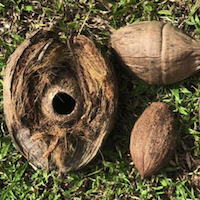Identifying the diversity of self-sown native coconuts (Cocos nucifera L.) and the introduced phenotype in Queensland, Australia

All claims expressed in this article are solely those of the authors and do not necessarily represent those of their affiliated organizations, or those of the publisher, the editors and the reviewers. Any product that may be evaluated in this article or claim that may be made by its manufacturer is not guaranteed or endorsed by the publisher.
The claims that all coconuts (Coco Nucifera L.) were introduced into Australia by Europeans were researched by studying the journals of the maritime expeditions, the records of the Queensland Acclimatisation Society, historical data and published papers. The 1869 minutes of the Queensland Acclimatisation Society stated that no introduced coconuts were fruiting, and the Queensland Governor stated that there were self-sown coconut palms on the coast. A large spherical niu vai phenotype was introduced from the 1870s to 1900. Field research was conducted in the vicinity of an historical coconut plantation at Wonga Beach. Nuts and palms were examined to understand if all coconuts in that region were descended from the introduced phenotype. Most self-sown coconuts are intermediate types with native Australian origins, not the introduced phenotype.
PAGEPress has chosen to apply the Creative Commons Attribution NonCommercial 4.0 International License (CC BY-NC 4.0) to all manuscripts to be published.


 https://doi.org/10.4081/pb.2021.9192
https://doi.org/10.4081/pb.2021.9192



